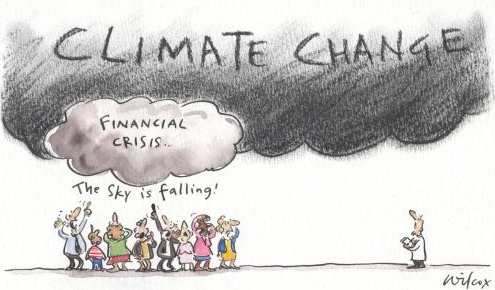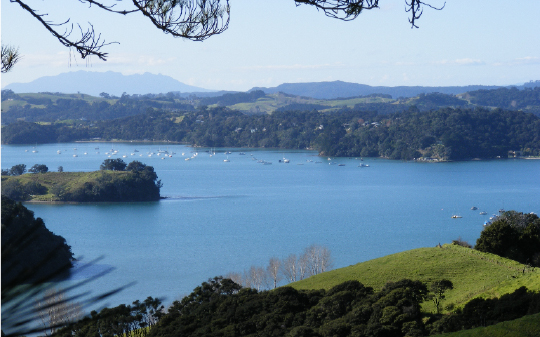Mahurangi not an island

Second Dip: Drawn during the first phase of the recession, but equally apposite post 5 August 2011. Cartoon Two Clouds Cathy Wilcox Sydney Morning Herald
It would be safer, to stick to the knitting.
Despite its ever-increasing readership—3643 visits last month—there is no knowing what percentage of the Mahurangi Magazine’s visitors would prefer to not read about anthropogenic global warming and the imperative for nuclear power and population reduction.
It is not as though there isn’t a huge task at hand locally to address the harbour’s elevated sediment accumulation rate—the principal driver for the Mahurangi Action Plan. And it doesn’t stop there, as the action plan attests. Recent residential development along the harbour’s scenic ridge roads threatens a core value of the Mahurangi. As Ron Locker put it in Jade River : A History of the Mahurangi:
Of the many scenic byroads in Rodney, the two most important are those that wind along the ridge tops to give access to Mahurangi West and East. They have assumed new significance as entries to the Regional Park.
The most used, as the nearest access from the city, and the most at risk, is the Mahurangi West Road (including Ngārewa Drive). If I seem to give it undue attention, it is because I know it well and see it as the prime example of threats that apply to other places in the area as well.
It has always been a very special road that marked the transition, in four miles from the busy highway north to the peace and out-of-this-world beauty of the estuaries. For years a muddy track, it kept at bay the motorised pleasure-seekers of the city, so saving the Heads for a future regional park. Now it is destined to serve as the principal gateway to the park. It is the strip of land that residents see most often; it affords the first impression for visitors.

Lookout for Action: Dr Ronald Locker’s top Mahurangi West Road lookout location is included in the Mahurangi Action Plan. Fortunately the property holder concurs, but considers that Auckland Council has a duty to contribute, by bearing the cost of removing the old and dying pine trees that obscure the best of the vista—this view was captured only after scaling one of the specimens. photographer Cimino Cole
Rising quickly to the highest ridge, it begins to unfold magnificent panoramas of the gulf: from Whangaparāoa to Moehau and Little Barrier. Looking northward the eye is mystified by the apparent complexity of the estuarine waterways; beyond, the Dome ridge and Tamahunga rise as a green wall.
This road is a scenic asset in its own right. It is as important as the regional park it serves and should have about six lay-bys where visitors could safely drink in the scene. These would serve also to emphasise the values of the road.
The bulk of the development pressure emanates from the metropolis, which is why it would have been fatal for its landscape had the Mahurangi been deprived of the protection of regional governance. Because while demand by individual city dwellers for a rural–coastal idyll fuels demand for development, collectively city dwellers support protection of the harbourscape.
Just as the Mahurangi cannot ignore the metropolis, it cannot ignore the global reality of soaring greenhouse gas levels and population, nor the peaked oil production that is causing the wheels to fall off the world’s fossil fuels-based economic growth. The twin plagues of soil and coastal erosion will only worsen thanks to more torrential rainfall events and non-linear sea level rise. Locally, an urgent plan is required for retiring and replanting slip-prone land and coastal margins. Fortunately, this work is being led by Auckland Council, thanks to the diligent science funded by its part-predecessor Auckland Regional Council. It and the Rodney District Council signed off on the Mahurangi Action Plan: A Strategic Plan for the Catchment 2010–2030 before the two councils were subsumed into the new Auckland Council. And the indications are good that awareness of the plan is high within the new single structure—it even got a mention in the draft Rodney Local Board Plan.
Regional action is one thing. But without strong national and international action on anthropogenic global warming and population, efforts to protect the Mahurangi catchment are futile. It is unlikely that the ice sheets can be saved, long term. And too little is known about ice sheet melt doubling time to know how quickly the 80-metre total possible sea level rise will transform Mahurangi Harbour into the Straits of Mahurangi. With a doubling time of 10 years, which is possibly optimistic, the sea level may only be about 85 millimetres higher by 2040. But by 2100 that could be five metres, and rising a galloping five metres per year to boot.

Forestry-Scale Indigenous: Trials in the Mahurangi of indigenous trees raised by open-ground methods are not only helping to protect the catchment but are pointing the way forward for the large-scale reforestation called for globally. photographer Jonathan Barran
The major political parties are proceeding with only a very limited range of climate actions. National’s establishment of the New Zealand Agricultural Greenhouse Gas Research Centre is exemplary, but in diabolical contrast, its Transport Minister’s addiction to motorways illustrates a fundamental failure to grasp the enormity of this unfolding global catastrophe. Sadly, this is understandable considering the slowness of voters to similarly comprehend the implications of global warming.
The best hope for Aotearoa doing its bit is for some Churchillian figure to materialise, or for an existing leader to so morph. The latter can’t be Phil Goff because, besides lacking vision, he lacks the chemistry to connect—the party is probably doomed to continue to arrogantly inflict further uncharismatic leaders on the public, seemingly having not noticed the galvanising effect of David Lange and Norman Kirk.
So, short of being delivered real leadership, it is down to people to demand meaningful climate action, and to make it safe for politicians to act with less timidity.
- Of course population must be reduced—fewer grandchildren, but better loved.
- Of course nuclear-powered ships must be welcomed by Aotearoa—bringing green tourism, and shipping food and quality timber products to the world.
- Of course genetically engineered trees and crops are required—every technology available must be put to use to adapt plants to the rapidly changing climate.
Genetically engineered flood-proof rice is a sublime example of how countless lives can be saved from events that would otherwise see famine cut its cruel swath.
Meantime, in the Mahurangi, forestry-style a.k.a open-ground indigenous trees are being trialled, not only to protect the catchment but with view to sustainably producing high quality timber. Aotearoa leads the world in exotic forestry methods, and could do so with indigenous—the transformation of the Amazon.
The harbour is bound to the rest of the globe by air above it, which is only about as deep as the Mahurangi tideway is long. Thus the Mahurangi community doesn’t have the luxury of concentrating on sediment to the exclusion of greenhouse gases.
The Mahurangi is not an island, yet.
Footnote Mahurangi Island, of course, is the sea stack off Waiwera.
